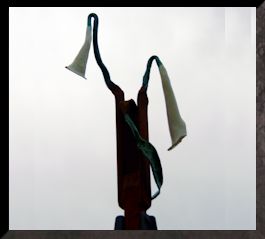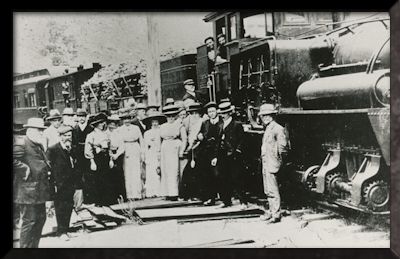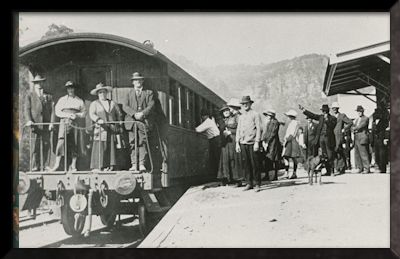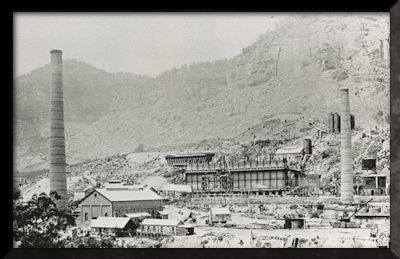 |

 |
Designer Phil Spark's comment:
"You can bicycle from Lithgow to Newnes along what’s left of the rail formation. It’s very overgrown in places so this has flowers (Arum lily’s, a weed but relatively easy to forge) growing out of a piece of skip rail." |
RAILWAY TO NEWNES COMPLETED
 |
Newnes Railway 1907
|
The Newnes Railway was an extension of the Main Western Line from Lithgow to the town of Newnes, deep within the Wolgan Valley. The line ran for 32 miles, or 51km. It was constructed and operated by the Commonwealth Oil Corporation for the Newnes oil and kerosene shale mines. It was primarily intended to carry goods to and from the mine but also provided passenger services.
The trains used on this line were unique, owing to the steepness of the gradients along the descent towards Newnes. Four Shay Locomotives were imported from the Lima Locomotive Works in Ohio, USA. Although rather slow, they used crankshafts to propel the wheels and a system of gears, enabling the train to start easily if it was forced to stop on a steep grade. They were also compatible with the gauge used on the main western line.
 |
Buildings of the ironworks
|
Newnes was a bustling town during the oil shale years. Oil shale had also been found at Hartley in 1866, at Torbane in 1865 and, later, Glen Davis. The Commonwealth Oil Corporation, which had been formed in London in 1905, bought out these leases in 1906, and acquired leases throughout the Capertee and Wolgan Valleys. Newnes, founded in that year was named after the chairman of the Commonwealth Oil Shale Company. Cutting the railway was a major investment but as newnes was a bustling town, it must have seemed worth it. However there were many industrial, technological and corporate failures and the works closed in 1912. The Works were relaunched by various interests, and during the Depression they were propped up by the Commonwealth Government as unemployment relief. However by 1938 all works had been relocated to Glen Davis.
The town of Newnes gradually disappeared. Only the Newnes hotel survives, and the Newnes Railway tunnel has become a favoured habitat for glow worms and is popularly known as Glow Worm Tunnel.
 |
Shale oil works at Newnes
|
SOURCES
A.S. Luchetti, Iris Paradaens, Allan Cargill, The Oil Shale Industry: Experience in the Western Coalfields of NSW, Lithgow District Historical Society, 1979
Home | About | Chronological List |
Contact Email
|
 |